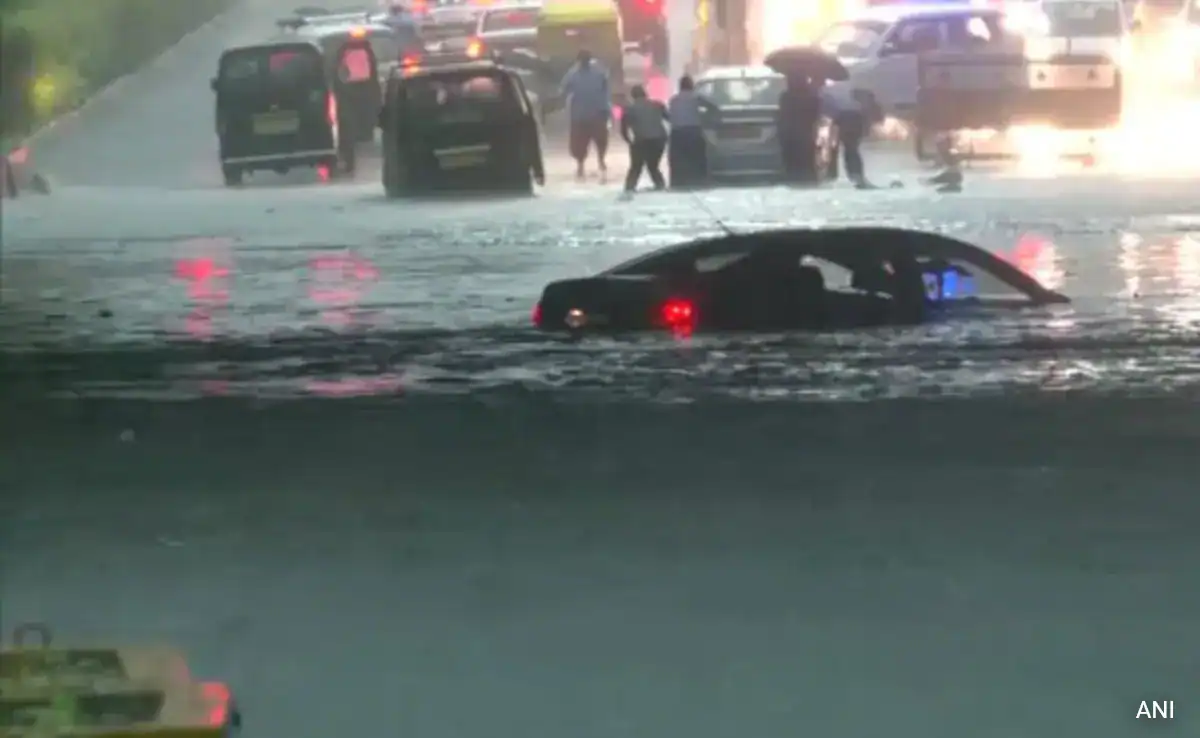Heavy Delhi-NCR rain caused severe waterlogging and traffic disruptions, leading to a roof collapse at IGI Airport’s Terminal 1 with one fatality and six injuries. Authorities are actively managing the crisis as the IMD forecasts continued rainfall.
New Delhi: The heavy Delhi-NCR rain on Friday wreaked havoc, causing severe waterlogging and significant disruptions across the region. One of the most critical incidents was the collapse of a roof at Terminal 1 of Indira Gandhi International Airport, resulting in one fatality and six injuries, according to ANI.
A fire official reported that several cars were buried under the collapsed roof at Terminal 1. Upon receiving the emergency call around 5:30 am, three fire tenders were dispatched to the scene. A rescue operation is ongoing to ensure no additional individuals are trapped in the damaged vehicles.
In response to the incident, Delhi International Airport Limited (DIAL) has temporarily halted all departures from Terminal 1, and check-in counters have been closed as a precautionary measure. Passengers scheduled to fly from Terminal 1 are being redirected to alternative terminals, and additional staff have been deployed to assist with the situation.

Immediate Impact and Response
The immediate impact of the roof collapse has been significant. Emergency services, including the fire department and medical teams, were quickly mobilized to handle the crisis. According to an official from Delhi Fire Services, the priority has been to rescue any trapped individuals and ensure that those injured receive prompt medical attention.
“Around 5.30 am, we received a call regarding a roof collapse at Terminal 1 of Delhi airport. Three fire engines have been rushed to the spot,” said an official from Delhi Fire Services. The incident has raised concerns about the infrastructure resilience at one of the busiest airports in the country, especially during extreme weather conditions like the heavy Delhi-NCR rain.

Traffic Disruptions in Delhi-NCR
The heavy Delhi-NCR rain, accompanied by thunderstorms and lightning, has led to severe waterlogging in various parts of the region. Areas such as Govindpuri in South Delhi and Noida Sector 95 are notably submerged. Visuals from these areas show extensive flooding, severely affecting traffic and daily activities.
In many parts of the city, vehicles were seen struggling to navigate through waterlogged streets, leading to significant traffic jams. The Delhi Traffic Police have issued advisories, urging commuters to avoid certain routes and take precautions while driving in waterlogged areas. Public transportation has also been impacted, with delays reported on several bus and metro routes.
Broader Impact on Daily Life
The relentless Delhi-NCR rain has not only disrupted transportation but also affected daily life in several ways. Schools in the affected areas have been closed as a precautionary measure, and many offices have advised employees to work from home. The heavy rain has also led to power outages in some regions, further complicating the situation for residents.
Authorities are on high alert, with emergency services working to manage the situation and provide relief to affected residents. The weather department has warned of continued rainfall and urged people to stay indoors and avoid waterlogged areas.

IMD Weather Forecast
The India Meteorological Department (IMD) has forecast generally cloudy skies with varying intensities of rain and gusty winds for the next seven days in Delhi. Here is the detailed forecast:
- June 29: The weather is expected to be slightly cooler, with temperatures ranging from a high of 36°C to a low of 28°C. Light to moderate rain or thunderstorms are likely, accompanied by winds reaching speeds of 30-40 km/h.
- June 30: Temperatures will drop further to a high of 34°C, with moderate to heavy rain and gusty winds.
- July 1 and 2: Thunderstorms with moderate rain are forecasted, with steady temperatures around highs of 34°C and lows of 27°C. Wind speeds are expected to vary between 25-35 km/h.
- July 3 and 4: Continued rainfall with occasional heavy showers. The temperatures are expected to hover around a high of 33°C and a low of 26°C. Winds will remain gusty, ranging from 20-30 km/h.
- July 5: A slight decrease in rainfall intensity, with mostly light to moderate showers expected throughout the day. The high temperature will be around 32°C, and the low will be about 25°C.

Long-Term Implications
This incident has brought to light the urgent need for better infrastructure resilience in the face of extreme weather events like the heavy Delhi-NCR rain. Experts suggest that more robust building standards and regular maintenance checks could prevent such accidents in the future. The Delhi government has announced an investigation into the roof collapse to determine whether there were any lapses in safety protocols.
Meanwhile, residents are advised to stay updated with weather forecasts and heed advisories from local authorities. With climate change leading to more unpredictable weather patterns, such incidents might become more frequent, necessitating better preparedness and response mechanisms.
Authorities continue to monitor the situation closely and are prepared to provide necessary assistance to residents affected by the adverse weather conditions. In the coming days, efforts will be focused on restoring normalcy, repairing damaged infrastructure, and ensuring that similar incidents do not occur in the future. The heavy Delhi-NCR rain serves as a reminder of the need for robust infrastructure and effective emergency response systems to handle such extreme weather events.
For further insights and comprehensive content, please visit our homepage



